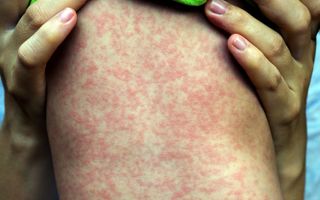This One Number Shows Why Measles Spreads Like Wildfire
But another factor is that the measles is an extremely contagious virus. And we mean extremely.
When doctors and scientists study how diseases spread, one factor they calculate is how many people, on average, are likely to become infected through contact with just one sick person.
That factor is measured by the basic reproduction number, or "R nought." And the higher that number, the more contagious the disease and the tougher it may be to contain within a population. For measles, the number is unusually high; this means that a single case can quickly spiral into a pandemic if people aren't protected through vaccination or natural immunity, experts told Live Science.
Infectious diseases such as polio, smallpox and rubella have R nought values in the 5 to 7 range — which means that one sick person would be likely to infect five to seven people who were not resistant to the virus, according to the Centers for Disease Control and Prevention (CDC). [The 9 Deadliest Viruses on Earth]
Ebola, which spread across Guinea, Liberia and Sierra Leone in 2014, is widely considered to be exceptionally contagious, but it has an R nought value of only 1.5 to 2, NPR reported that year. Whooping cough has an R nought value of 5.5, according to a study published in 2010 in the journal PLoS Medicine, and SARS has an R nought value in the 3 to 4 range, researchers reported in 2004 in the American Journal of Epidemiology.
Yet, all these are far outstripped by the R nought value assigned to measles: 12-18, the CDC says.
Crunching numbers
R nought values are calculated using a number of factors, including how long an infected person remains contagious, the likelihood of contact between that person and someone vulnerable to infection, and other factors related to disease transmission, according to a study published in the January 2019 issue of the journal Emerging Infectious Diseases.
Sign up for the Live Science daily newsletter now
Get the world’s most fascinating discoveries delivered straight to your inbox.
The calculations also take into account the characteristics of the virus itself, such as how it spreads and how long it can survive outside of a human host. Other factors include where in the world the virus is found and how often people in the affected area come into contact with each other, said Paul Delamater, an assistant professor in the department of geography in the University of North Carolina at Chapel Hill and lead author of the Emerging Infectious Diseases study.
"There's a host of social, cultural and demographic characteristics of places that would make the R nought value differ from place to place," Delameter told Live Science. In other words, R nought values aren't absolutes; they can vary depending on human behavior in areas where the data is collected, he said.
"R nought can be much higher in a place with lots of contact on average compared to a place with less contact on average," he said. [Tiny & Nasty: Images of Things That Make Us Sick]

A persistent pathogen
So, what factors contribute to the measles' unusually high R nought value?
In part, that high value is due to how the virus spreads. The measles virus is expelled from the body when an infected person coughs or sneezes, "and the virus particles can remain suspended in the air for up to 2 hours," said study co-author Kathryn Jacobsen, a professor of epidemiology and global health at George Mason University in Fairfax, Virginia.
"That means that one infected person at work or school, commuting, running errands, or traveling can leave a cloud of virus that exposes dozens or hundreds of people to measles," Jacobsen told Live Science. "By contrast, the risk of Ebola virus transmission is relatively low, because people contract Ebola only by touching the skin or body fluids of an infected individual."
What's more, people with the measles are typically contagious for about four days before the telltale rash appears. So, by the time they realize they're sick, they've had days to infect others, Jacobsen said.
The high R nought value for measles means that a single case requires an urgent public health response. On the other hand, infectious diseases with very low R nought values "usually do not require public health action, because they are unlikely to become epidemics," Jacobsen said.
Still, Delamater noted that as R nought numbers can change based on the level of human contact in the place where a disease emerges, the values shouldn't be treated as fixed or universal for every outbreak.
"R nought can help us get a general idea about the ability of the disease to be transmitted in populations, but it's not a magic number that has all the answers," he said.
- Measles: Symptoms & Treatment
- Germs on the Big Screen: 11 Infectious Movies
- 27 Devastating Infectious Diseases
Editor's note: This story was corrected on Feb. 11 to update the sources for R nought values for whooping cough and SARS.
Originally published on Live Science.

Mindy Weisberger is an editor at Scholastic and a former Live Science channel editor and senior writer. She has reported on general science, covering climate change, paleontology, biology, and space. Mindy studied film at Columbia University; prior to Live Science she produced, wrote and directed media for the American Museum of Natural History in New York City. Her videos about dinosaurs, astrophysics, biodiversity and evolution appear in museums and science centers worldwide, earning awards such as the CINE Golden Eagle and the Communicator Award of Excellence. Her writing has also appeared in Scientific American, The Washington Post and How It Works Magazine.
